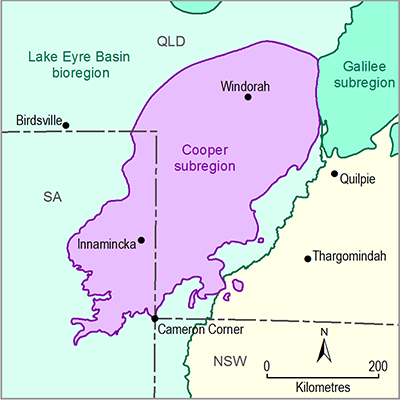The Cooper subregion contributes surface water predominantly to Cooper creek basin and a small proportion to Diamantina river basin by its floodplain pathways and numerous creeks. Both of these river basins are characterised by large variations in discharge and flow duration. Streamflow monitoring stations are relatively sparse in the Cooper subregion. A list of available stream gauges within and adjacent to the Cooper subregion along with their length of record is given in Table 9 (DNRM, 2013). Detail of streamflow characteristics of the Cooper creek basin, part of the Cooper Creek – Bulloo river basin, and Diamantina river basin, part of the Diamantina–Georgina river basin, are described in the subsequent sections.
Table 9 List of stream gauges in the Cooper subregion and surrounding areas located in the Cooper creek basin and Diamantina river basin
Water in the Cooper creek basin is predominantly derived from runoff from headwater catchments. The Thomson and Barcoo rivers, which originate outside the Cooper subregion, play an important role in flow into Cooper Creek. Transmission losses are generally very high. The long-term (1901–2003) average modelled runoff coefficient in the Cooper creek basin varies from a low of 1.2% for the Alice River at Barcaldine to a high of 6.6% for the Thomson River at Stonehenge. The runoff coefficients are 5.8% at Currareva and 1.6% at Nappa Merrie (McMahon et al., 2005).
Streamflow in Cooper Creek and its tributaries varies greatly between years from almost no flow to significant flooding, and between months with no flow for some months. Figure 31 shows an example of yearly and monthly flow distribution based on measured data (1966–2012) at Nappa Merrie (DNRM, 2013). Watercourses in this basin are ephemeral and carry water mostly between January and July. The maximum monthly flow varies depending on the location of the gauging site and contributing catchment area, with some sites having very high flows (up to 15,900 GL/month for Cooper Creek at Currareva). Both annual and monthly flows generally increase down the catchment, although there are exceptions to this trend. On average there is flow in Cooper Creek at Nappa Merrie about 60% of the time. The flow duration curves are steep for all gauging sites in the Cooper creek basin, confirming the observation that streamflow is highly variable and that there is little groundwater contribution to the overall flow (McMahon et al., 2005).
Due to its low gradient, water flows very slowly on the floodplain. For a large flood, it takes around 16 days for the water to pass through the floodplain with a wave speed of 0.3 m/s, while for a small flood the speed can be as low as 0.1 m/s (Costelloe et al., 2003). The long travel time allows the air and earth to absorb much of the water on the flat floodplain. On average the water of the Cooper Creek reaches Lake Eyre only once in every six years (Kingsford et al., 1999). For the biggest flood in the recorded history of Cooper Creek (1974), around 25,000 GL of water inundated the creek and 40% of the water was lost by the time the flood peak arrived in Callamurra near the Queensland–SA border. For flow events below 5000 GL, the transmission loss is often above 80% (McMahon et al., 2005).
Data: DNRM (2013)
1.1.5.3.1 Diamantina river basin
The flow regimes of the Diamantina River are dominated by late summer flow events resulting from highly variable monsoonal rainfall in the upper catchments. Due to the location of the catchment, which includes semi-arid and arid regions, the streams are ephemeral (Knighton and Nanson, 2001). Like many arid zone rivers, the Diamantina river basin has few gauging stations to record streamflow, with two stations currently operating: one at Oondooroo on the Mills Creek and the other at Diamantina Lakes on the Diamantina River (Figure 30). Streamflow varies greatly between years and months from almost no flow to significant flooding. Figure 32 shows an example of yearly and monthly flow distribution based on measured data (1966–2012) at Diamantina Lakes on the Diamantina River (DNRM, 2013). The maximum monthly flows vary depending on the location and contributing catchment area, with some stations having high maximum mean monthly flows of up to 574 GL/year at Diamantina Lakes and 926 GL/year at Birdsville. On average, this catchment contributes some inflow to Lake Eyre North every two years (Kotwicki, 2005). At Diamantina Lakes, cease-to-flow conditions occur approximately 53% of the time (Costelloe et al., 2003).
Data: DNRM (2013)



